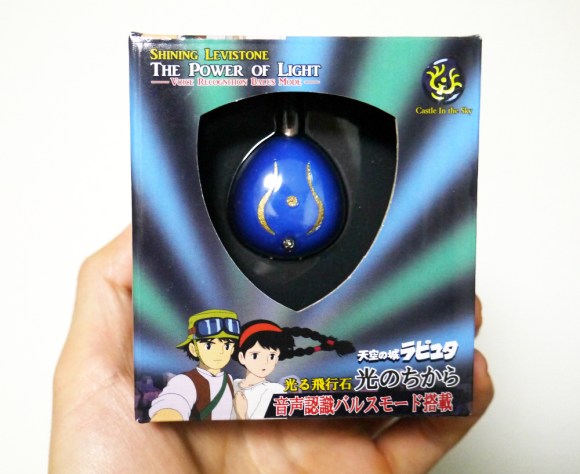
We’re sure many anime fans shared our excitement last May when the newest replica of the pendant from Studio Ghibli’s Castle in the Sky was announced. Sure, there had been chances to buy a necklace modeled after heroine Sheeta’s magical levistone accessory before, but this was the first time we’d be able to get our hands on one that actually reacts when you speak one of the film’s incantations into it.
Likewise, we’re sure many of the Ghibli faithful were as heartbroken as we were when the initial shipment of the special pendants sold out almost immediately. Still, the six months it took for a restock was a just a minor addition to the 20-plus years we’ve been waiting to try the pedant out since we first saw Laputa.
Now, finally, we’ve got the levistone pendant in our hands, and we’re ready to field test its ability to respond to our mystic commands.
In the film, uttering the word balus (or, since Japanese doesn’t actually have the letter L or terminal consonants, “barus” or “barusu”), triggers the terrible Spell of Destruction. But it’s one thing for an in-anime artifact created though powerful, ancient, and mysterious means to react when spoken to, and another for a 2,400-yen (US$20) anime trinket to do the same. Would our store-bought levistone pendant really be able to tell the difference between “balus” and other, similar-sounding words like ballet, bulb, browse, and banana? We had a sneaking suspicion that the accessory might just be rigged to react whenever it picked up any noise, so we decided to put it to the test.
As you can see in the video above, the pendant passed with flying colors, remaining inactive in the face of our many attempts to trick it. As soon as we said “balus,” though, a blue light began to flash from within, although thankfully this wasn’t followed by the office collapsing and our team of writers and editors tumbling to the Shinjuku streets below.
Frequent Laputa viewers, or simply the ones with incredibly sharp memories, may also remember a second spell Sheeta was taught by her grandmother, which is activated by the lengthy phrase “Leetay latuparita ulus arialos balu netoreel,” which is supposed to mean “Save me and revive the eternal light” in the lost language of the Laputans. If you can say the whole thing without getting tongue-tied, the pendant will reward you by flashing in a different, less aggressive pattern, although again the anime’s exact on-screen effect, awakening a fire-spewing guardian robot, is not duplicated.
And once more, try as we might with sneaky alternatives like “Detail margarita lose Ariel’s blue metro eel,” there was no fooling the pendant. This thing is seriously clever.
Some of you might be wondering about all those Ls and Rs in “Leetay latuparita ulus arialos balu netoreel.” As we said above, there’s no L in the Japanese language, and the sound is usually switched to something close to an R in adopting foreign words and phrases. So to activate the levistone pendant, should you use all Japanese-style Rs, or mix in a few Ls for good measure?
Actually, it doesn’t seem to matter. As shown in our video, we tested it both with a Japanese-language native, whose pronunciation was chock-full of Rs, and an English native who favored Ls for most instances. Both brought forth the pendant’s mystical light, leading us to think that maybe what’s inside isn’t an audio sensor, but an actual bit of magic.
Related: Excite
Photos © RocketNews24
 New Laputa amulet actually responds when you incant the anime’s magic spells
New Laputa amulet actually responds when you incant the anime’s magic spells Those awesome voice-activated Laputa pendants that just hit stores? They’re already sold out
Those awesome voice-activated Laputa pendants that just hit stores? They’re already sold out Beautiful new Levistone from Ghibli’s Laputa anime going on sale soon, so order yours ASAP【Video】
Beautiful new Levistone from Ghibli’s Laputa anime going on sale soon, so order yours ASAP【Video】 New Ghibli T-shirts let you carry No Face and the Levitation Stone in your pocket
New Ghibli T-shirts let you carry No Face and the Levitation Stone in your pocket Red light district sushi restaurant in Tokyo shows us just how wrong we were about it
Red light district sushi restaurant in Tokyo shows us just how wrong we were about it Japanese ramen restaurants under pressure from new yen banknotes
Japanese ramen restaurants under pressure from new yen banknotes Anime girl English teacher Ellen-sensei becomes VTuber/VVTUber and NFT
Anime girl English teacher Ellen-sensei becomes VTuber/VVTUber and NFT McDonald’s new Happy Meals offer up cute and practical Sanrio lifestyle goods
McDonald’s new Happy Meals offer up cute and practical Sanrio lifestyle goods Pokémon Sleep camping suite and guestrooms coming to Tokyo Hyatt along with giant Snorlax burgers
Pokémon Sleep camping suite and guestrooms coming to Tokyo Hyatt along with giant Snorlax burgers Sandwiches fit for a sumo served up in Osaka【Taste Test】
Sandwiches fit for a sumo served up in Osaka【Taste Test】 Tokyo Tsukiji fish market site to be redeveloped with 50,000-seat stadium, hotel, shopping center
Tokyo Tsukiji fish market site to be redeveloped with 50,000-seat stadium, hotel, shopping center Secret Kitchen bento serves Japanese flowers, birds, wind and moon in a box, but is it worth it?
Secret Kitchen bento serves Japanese flowers, birds, wind and moon in a box, but is it worth it? Akihabara pop-up shop sells goods made by Japanese prison inmates
Akihabara pop-up shop sells goods made by Japanese prison inmates Wendy’s releases a Pretzel Roast Beef Burger aimed at foreign tourists in Japan
Wendy’s releases a Pretzel Roast Beef Burger aimed at foreign tourists in Japan All-you-can-drink Starbucks and amazing views part of Tokyo’s new 170 meter-high sky lounge
All-you-can-drink Starbucks and amazing views part of Tokyo’s new 170 meter-high sky lounge More foreign tourists than ever before in history visited Japan last month
More foreign tourists than ever before in history visited Japan last month French Fries Bread in Tokyo’s Shibuya becomes a hit on social media
French Fries Bread in Tokyo’s Shibuya becomes a hit on social media Studio Ghibli releases new action figures featuring Nausicaä of the Valley of the Wind characters
Studio Ghibli releases new action figures featuring Nausicaä of the Valley of the Wind characters New private rooms on Tokaido Shinkansen change the way we travel from Tokyo to Kyoto
New private rooms on Tokaido Shinkansen change the way we travel from Tokyo to Kyoto Starbucks reopens at Shibuya Scramble Crossing with new look and design concept
Starbucks reopens at Shibuya Scramble Crossing with new look and design concept Studio Ghibli glasses cases let anime characters keep an eye on your spectacles
Studio Ghibli glasses cases let anime characters keep an eye on your spectacles Beautiful Ghibli sealing wax kits let you create accessories and elegant letter decorations【Pics】
Beautiful Ghibli sealing wax kits let you create accessories and elegant letter decorations【Pics】 Studio Ghibli releases Kiki’s Delivery Service chocolate cake pouches in Japan
Studio Ghibli releases Kiki’s Delivery Service chocolate cake pouches in Japan New definition of “Japanese whiskey” goes into effect to prevent fakes from fooling overseas buyers
New definition of “Japanese whiskey” goes into effect to prevent fakes from fooling overseas buyers Our Japanese reporter visits Costco in the U.S., finds super American and very Japanese things
Our Japanese reporter visits Costco in the U.S., finds super American and very Japanese things Studio Ghibli unveils Mother’s Day gift set that captures the love in My Neighbour Totoro
Studio Ghibli unveils Mother’s Day gift set that captures the love in My Neighbour Totoro New Japanese KitKat flavour stars Sanrio characters, including Hello Kitty
New Japanese KitKat flavour stars Sanrio characters, including Hello Kitty New Pokémon cakes let you eat your way through Pikachu and all the Eevee evolutions
New Pokémon cakes let you eat your way through Pikachu and all the Eevee evolutions Disney princesses get official manga makeovers for Manga Princess Cafe opening in Tokyo
Disney princesses get official manga makeovers for Manga Princess Cafe opening in Tokyo Sales of Japan’s most convenient train ticket/shopping payment cards suspended indefinitely
Sales of Japan’s most convenient train ticket/shopping payment cards suspended indefinitely Sold-out Studio Ghibli desktop humidifiers are back so Totoro can help you through the dry season
Sold-out Studio Ghibli desktop humidifiers are back so Totoro can help you through the dry season Japanese government to make first change to romanization spelling rules since the 1950s
Japanese government to make first change to romanization spelling rules since the 1950s Ghibli founders Toshio Suzuki and Hayao Miyazaki contribute to Japanese whisky Totoro label design
Ghibli founders Toshio Suzuki and Hayao Miyazaki contribute to Japanese whisky Totoro label design Doraemon found buried at sea as scene from 1993 anime becomes real life【Photos】
Doraemon found buried at sea as scene from 1993 anime becomes real life【Photos】 Tokyo’s most famous Starbucks is closed
Tokyo’s most famous Starbucks is closed One Piece characters’ nationalities revealed, but fans have mixed opinions
One Piece characters’ nationalities revealed, but fans have mixed opinions We asked a Uniqlo employee what four things we should buy and their suggestions didn’t disappoint
We asked a Uniqlo employee what four things we should buy and their suggestions didn’t disappoint Princesses, fruits, and blacksmiths: Study reveals the 30 most unusual family names in Japan
Princesses, fruits, and blacksmiths: Study reveals the 30 most unusual family names in Japan Kimi no Na Wa jewellery released to celebrate success of Japanese anime film “your name.”
Kimi no Na Wa jewellery released to celebrate success of Japanese anime film “your name.” New “pink light” system for pregnant passengers trialled on subway in South Korea【Video】
New “pink light” system for pregnant passengers trialled on subway in South Korea【Video】 Beautiful Ghibli sealing wax kits let you create accessories and elegant letter decorations【Pics】
Beautiful Ghibli sealing wax kits let you create accessories and elegant letter decorations【Pics】 Studio Ghibli debuts new loungewear collection inspired by its dynamic, beloved heroines
Studio Ghibli debuts new loungewear collection inspired by its dynamic, beloved heroines Studio Ghibli loungewear lets you cosplay as an anime heroine at home
Studio Ghibli loungewear lets you cosplay as an anime heroine at home Park your backside on a Princess Mononoke face mask cushion
Park your backside on a Princess Mononoke face mask cushion Head to Tokyo or Nagoya to make your own custom Pokémon jewelry from 87 cute designs
Head to Tokyo or Nagoya to make your own custom Pokémon jewelry from 87 cute designs His name is Balse and he looks like Colonel Muska: Japanese netizens go wild for new French PM
His name is Balse and he looks like Colonel Muska: Japanese netizens go wild for new French PM Hello Kitty skull ring and skull necklace are totally cute and metal as f#@%
Hello Kitty skull ring and skull necklace are totally cute and metal as f#@% New Princess Mononoke accessory line has Kodama for your ears, wolves for your fingers【Photos】
New Princess Mononoke accessory line has Kodama for your ears, wolves for your fingers【Photos】 Traditional silverwork pairs with the power of the moon in this stunning Silver Crystal pendant
Traditional silverwork pairs with the power of the moon in this stunning Silver Crystal pendant Wear a genuine piece of Japanese sword around your neck with beautiful new jewellery range
Wear a genuine piece of Japanese sword around your neck with beautiful new jewellery range New Sailor Moon Prism necklaces to include chocolate, retail for 98 cents!
New Sailor Moon Prism necklaces to include chocolate, retail for 98 cents!
Leave a Reply